Overview
This article presents five essential steps for selecting the ideal flooring for retail stores. It begins by emphasizing the importance of understanding space requirements, which sets the foundation for informed decision-making. Next, exploring various material options allows business owners to evaluate the aesthetic and functional needs of their space. Durability and maintenance needs are critical factors, especially in high-traffic areas, and must be carefully assessed. Budget constraints play a significant role in the final selection, ensuring that choices align with financial realities. Lastly, firsthand experience with flooring samples is crucial; it enables a tangible connection to the materials, reinforcing their suitability. Each of these steps highlights vital considerations such as durability, maintenance, and budget, ultimately guiding retail owners toward a flooring solution that meets their operational challenges effectively.
Introduction
Selecting the appropriate flooring for a retail store transcends mere design choices; it profoundly impacts customer experience and operational efficiency. With an extensive array of materials available—from luxury vinyl tiles to hardwood and carpet—grasping the unique demands of a retail space is crucial.
What key factors should retailers prioritize to ensure their flooring not only elevates aesthetics but also endures the challenges of high foot traffic?
This guide explores the essential steps for choosing the optimal flooring, striking a balance between durability, maintenance, and budget considerations to cultivate an inviting shopping atmosphere.
Understand Your Retail Space Requirements
Begin by thoroughly assessing the dimensions and layout of your retail space. It is essential to precisely evaluate the overall area and analyze foot traffic patterns, identifying high-traffic zones such as entrances and checkout sections where durability is paramount. For example, commercial Luxury Vinyl Flooring (LVF) stands out as an ideal option for flooring for retail stores due to its durability, as it can withstand heavy foot traffic, resist scratches and stains, and offer exceptional water resistance.
Additionally, consider the current conditions, including lighting and climate, as these factors can significantly impact the performance of your flooring surfaces. Areas with expansive windows may necessitate surfaces that resist fading from sunlight, such as polished concrete or vinyl flake options, which also provide straightforward maintenance. Furthermore, customer comfort is crucial, particularly for those spending extended periods standing or walking on the floor.
Carefully document these specifications, including upkeep expenses, to facilitate a more efficient surface selection process. This ensures that the chosen materials align with both aesthetic and functional requirements, ultimately enhancing the overall customer experience.
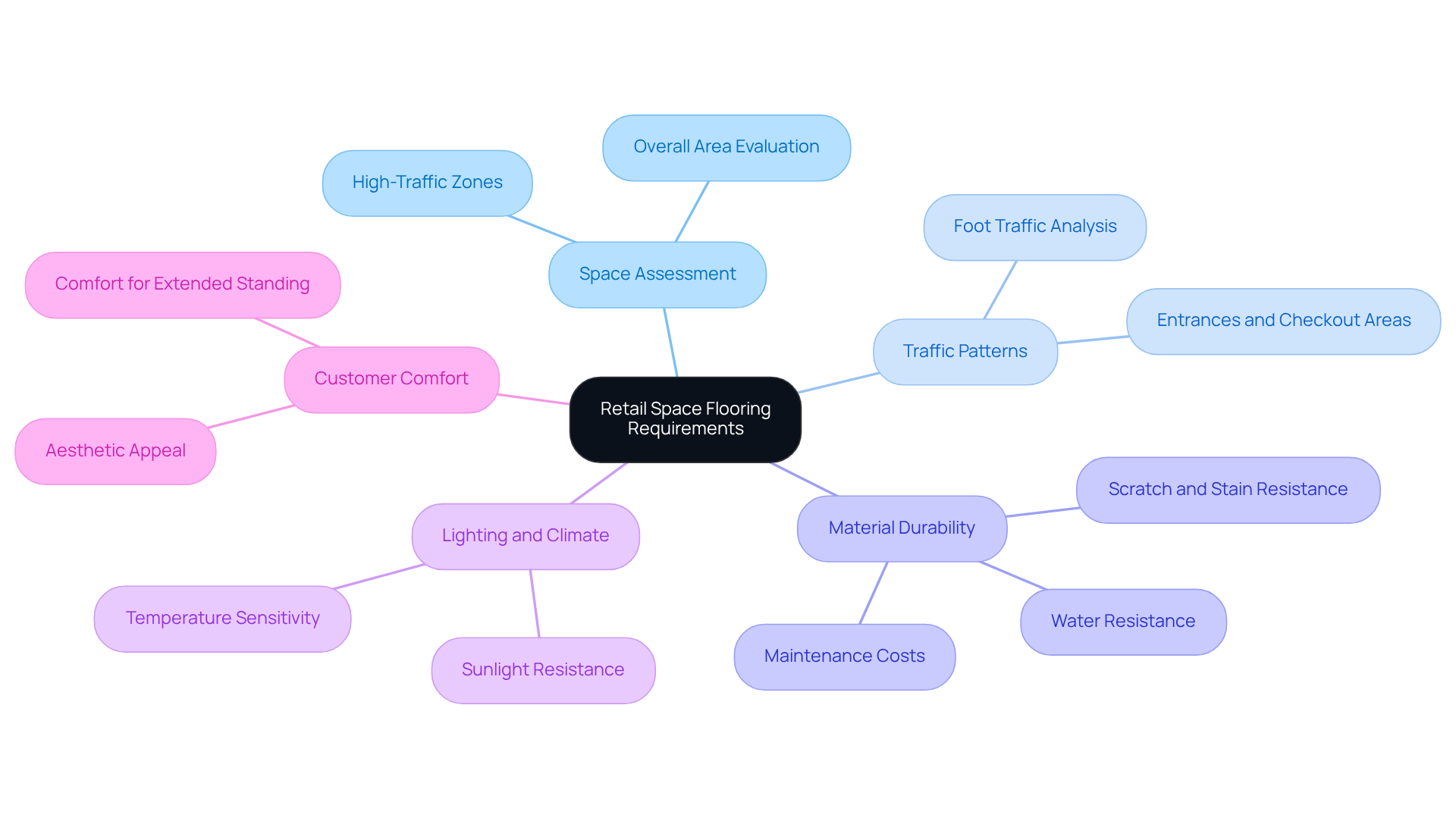
Explore Flooring Material Options
When selecting flooring for retail stores, consider options like luxury vinyl tile (LVT), laminate, hardwood, and carpet tiles—each offering distinct advantages that can significantly impact your space.
-
Luxury Vinyl Tile (LVT) stands out for its durability and water resistance, making it particularly well-suited for high-traffic areas. It endures heavy foot traffic while preserving a polished appearance, positioning it as a preferred choice for flooring for retail stores. Furthermore, LVT's ability to replicate natural materials through high-definition printing enhances visual appeal without the maintenance challenges associated with traditional flooring. Recent advancements, such as built-in underlayments for improved sound absorption, further bolster its suitability for open office designs.
-
Laminate presents a cost-effective alternative that is easy to install and offers a variety of styles. However, it may not withstand heavy wear as effectively as LVT, making it less ideal as flooring for retail stores in bustling environments. The contrast is clear: LVT excels in resisting scratches, water, and heavy foot traffic.
-
Hardwood delivers a classic and sophisticated look, yet it demands more maintenance and is vulnerable to scratches and moisture. While its aesthetic value can enhance brand identity, the upkeep required for flooring for retail stores in high-traffic environments is a crucial consideration.
-
Carpet Tiles offer comfort and sound absorption, making them ideal for spaces where acoustics are paramount. However, their cleaning challenges, especially in high-use areas, should not be overlooked.
When assessing these materials, reflect on the aesthetic you wish to achieve and how each option aligns with your brand identity. The trend of utilizing various substances for improved space zoning and visual attractiveness is gaining traction, allowing for innovative layouts that elevate overall design. Compile a shortlist of materials that meet your operational requirements while factoring in durability and maintenance needs. Additionally, incorporating insights from industry leaders can provide valuable perspectives on the advantages of each flooring type.
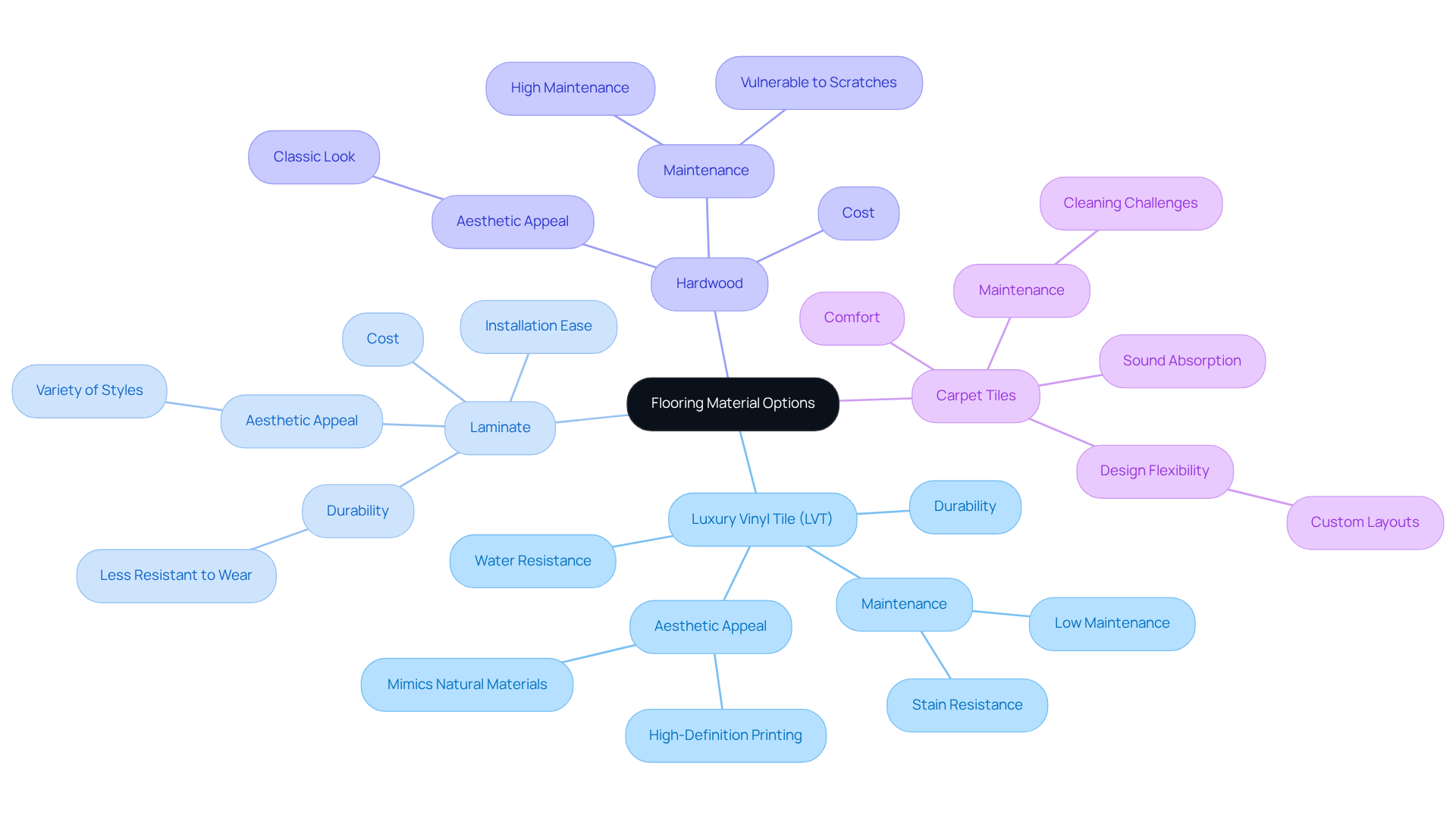
Evaluate Durability and Maintenance Needs
Assess the anticipated wear and tear on your surface by considering foot traffic and the specific activities within your retail area. In locations with heavy footfall, prioritize durable materials such as luxury vinyl tile (LVT) or commercial-grade carpet, which are engineered to withstand continuous use. As noted, high-traffic areas, such as lobbies, hallways, or flooring for retail stores, require surfaces that can endure constant wear and tear.
Maintenance requirements vary significantly among surface types; for example, hardwood surfaces may necessitate occasional refinishing to maintain their appearance, whereas LVT typically requires only basic mopping for upkeep. In fact, vinyl surfaces can last for up to 20 years with proper care, making them a practical choice for flooring for retail stores.
To ensure durability and optimal functionality, develop a comprehensive care plan that includes cleaning schedules and specific maintenance tasks tailored for each surface type. For instance, a care strategy for LVT might involve:
- Regular sweeping
- Occasional damp mopping
While carpet may need:
- Routine vacuuming
- Periodic deep cleaning
Consistent vacuuming and deep cleaning are crucial for maintaining commercial carpets. By proactively addressing these maintenance requirements, you can extend the lifespan of your surfaces and maintain a polished appearance that enhances the shopping experience. Furthermore, remember that professional installation is essential for ensuring the longevity of your surface components.
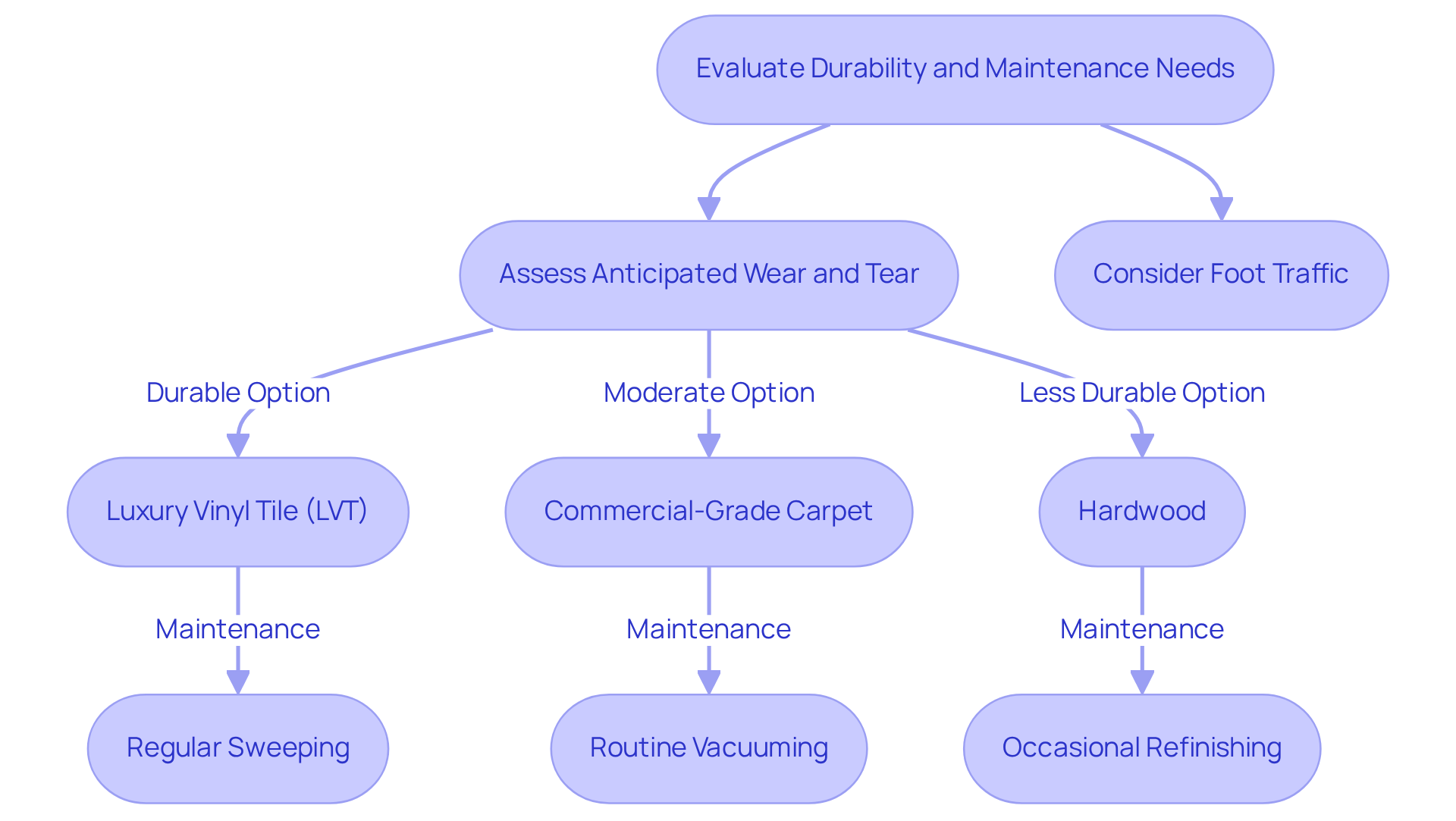
Assess Your Budget Constraints
Establishing a clear budget for your installation project is crucial. Begin by considering all expenses, including resources, installation, and additional costs such as underlayment and maintenance supplies. For example, the typical expense to install laminate surfaces ranges from $5,000 to $12,000 for 1,000 square feet, whereas hardwood installation can vary from $600 to $2,000 for a 200-square-foot room. Installation expenses can fluctuate significantly based on the complexity of the task, making it essential to investigate the price ranges for your selected materials.
To safeguard against unforeseen expenses, consider reserving a contingency fund of 10-20% of your total budget. This buffer can accommodate unexpected costs, such as mold remediation, which may range from $9 to $23 per square foot. Furthermore, explore financing options or discounts from suppliers to extend your budget further. By maintaining financial clarity, you empower yourself to make informed decisions that uphold quality without overspending.
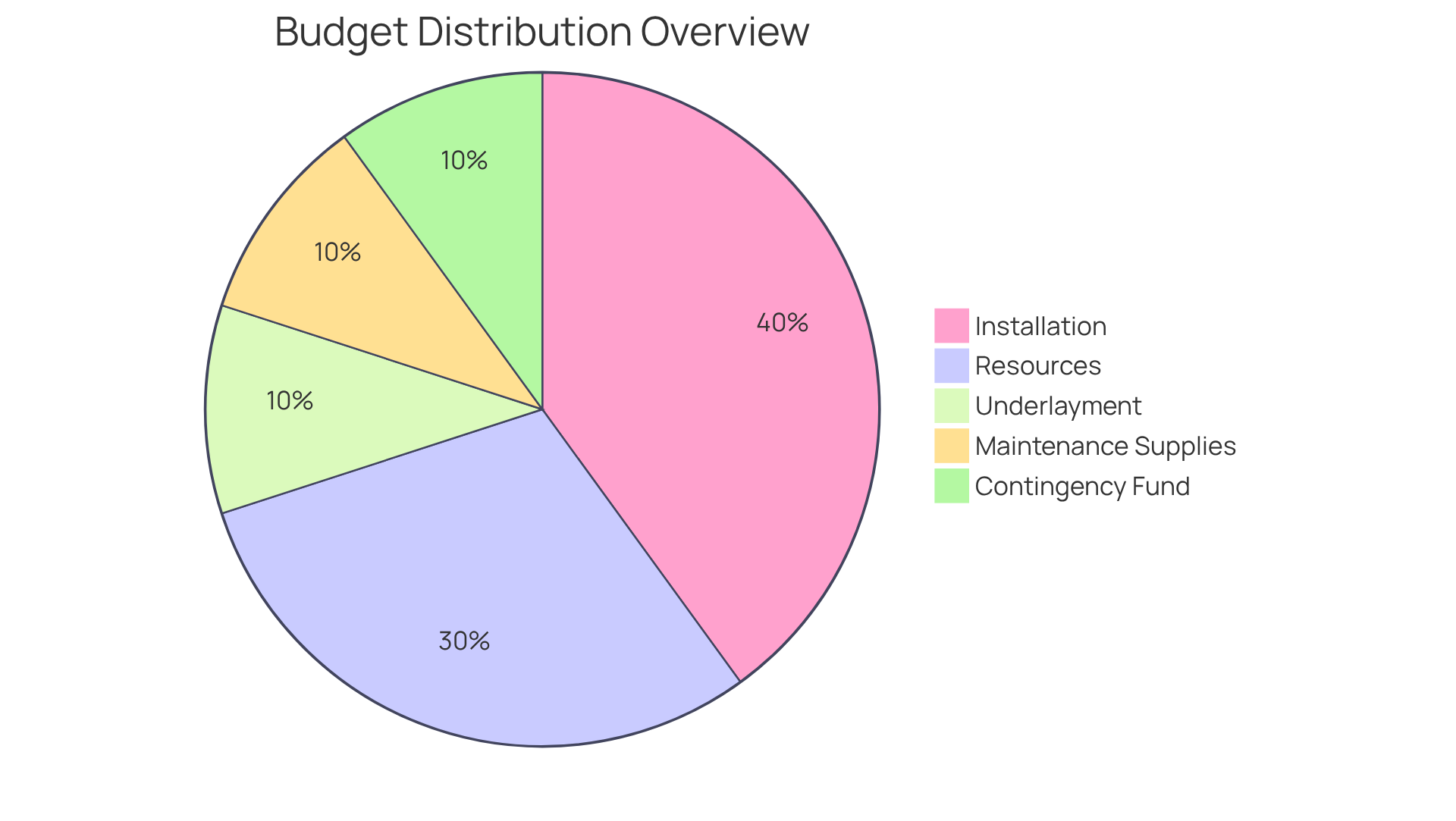
Finalize Your Flooring Selection
After gathering all essential information, revisit your shortlisted options for flooring for retail stores and evaluate them against your requirements, such as durability, maintenance, and budget.
Visiting showrooms is crucial; it allows you to experience full-size samples and assess their appearance and feel firsthand. Engaging with surface specialists can provide valuable insights into installation timelines and warranties, which typically range from 5 to 30 years depending on the material. For example, installation may take as little as one day for a small room, while larger spaces could require several days. Understanding these timelines is vital for effectively coordinating your project.
Moreover, 86% of consumers read online reviews before purchasing floor coverings, highlighting the importance of reputation management in your decision-making process. Once you have reached a decision, proceed to place your order and schedule installation. Ensure that all stakeholders are informed and prepared for the transition to your new surfaces, as this clarity streamlines the process and enhances overall satisfaction.
Remember, visiting a showroom allows you to touch and feel various samples of flooring for retail stores, which builds confidence in your choices.
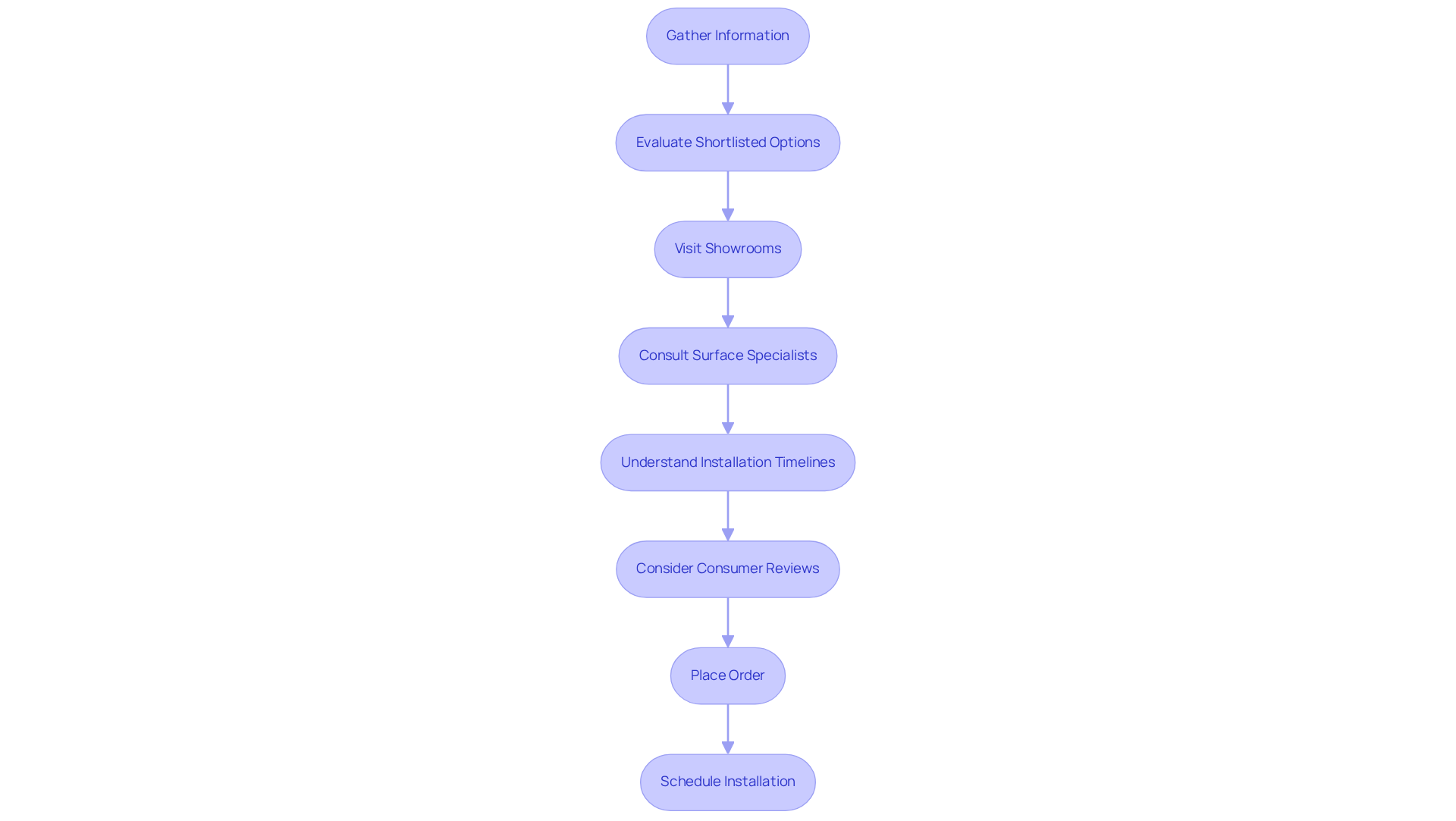
Conclusion
Selecting the right flooring for retail stores is a multifaceted process that demands careful consideration of various factors to create an inviting and functional environment. The primary objective is to choose flooring that enhances the aesthetic appeal of the space while meeting the practical demands of high foot traffic and maintenance.
Key steps in this process include:
- Understanding the specific requirements of the retail space
- Exploring different flooring material options
- Evaluating durability and maintenance needs
- Assessing budget constraints
- Finalizing the flooring selection
Each of these steps plays a vital role in ensuring that the chosen flooring aligns with the store's operational needs and reflects its brand identity.
In conclusion, selecting the ideal flooring for retail spaces is crucial for enhancing customer experience and operational efficiency. By taking the time to assess the unique characteristics of the space and considering factors such as durability, maintenance, and budget, retailers can make informed decisions that lead to long-lasting and visually appealing results. Embracing this comprehensive approach not only elevates the shopping experience but also contributes to the overall success of the retail environment.
Frequently Asked Questions
What should I consider when assessing my retail space requirements?
Assess the dimensions and layout of your retail space, evaluate foot traffic patterns, and identify high-traffic zones. Consider the current conditions, such as lighting and climate, as these factors can impact flooring performance. Document specifications, including upkeep expenses, to aid in selecting suitable flooring materials.
Why is Luxury Vinyl Flooring (LVF) recommended for retail stores?
Luxury Vinyl Flooring (LVF) is durable, can withstand heavy foot traffic, resists scratches and stains, and offers exceptional water resistance, making it ideal for retail environments.
What flooring options are available for retail stores?
Available flooring options include Luxury Vinyl Tile (LVT), laminate, hardwood, and carpet tiles, each with distinct advantages that can impact the retail space.
How does Luxury Vinyl Tile (LVT) compare to other flooring options?
LVT is highly durable and water-resistant, making it suitable for high-traffic areas. It preserves a polished appearance and can replicate natural materials without the maintenance issues of traditional flooring.
What are the pros and cons of laminate flooring for retail spaces?
Laminate is a cost-effective and easy-to-install option with various styles. However, it may not withstand heavy wear as effectively as LVT, making it less ideal for bustling retail environments.
What are the maintenance considerations for hardwood flooring in retail stores?
Hardwood flooring offers a classic look but requires more maintenance and is vulnerable to scratches and moisture, which can be challenging in high-traffic areas.
When are carpet tiles a good choice for retail spaces?
Carpet tiles provide comfort and sound absorption, making them suitable for areas where acoustics are important. However, they can be challenging to clean in high-use areas.
How can I determine the best flooring material for my retail store?
Reflect on the aesthetic you wish to achieve and how each flooring option aligns with your brand identity. Consider durability and maintenance needs, and compile a shortlist of materials that meet your operational requirements.




